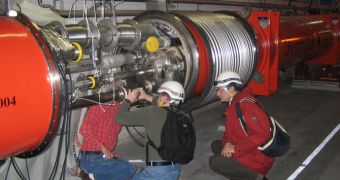In the past few months, the Large Hadron Collider slowly disappeared from public attention and kept an increasingly lower profile. However, just when not much was expected to be heard about it – since the last statements did not have anything interesting programmed LHC-wise until next June – something actually did occur. And it did not get any better. It seems that the repair works for the massive device located at the Swiss-French border will take even longer, and it will not be ready for the experiment until the late summer of next year.
That is, if Plan A will still be maintained until then, as the CERN officials claim so far. Nevertheless, they got us used to so much change, that it is rather hard to believe anything until concrete results are actually observed. A short briefing for those who forgot or never knew (although it's a little bit impossible, with all the big fuss going on until September) – LHC is a giant machine that will smash particle beams against each other at incredible speeds, in order to test the laws of physics, understand the universe, and discover new particles.
When all seemed to go well and the big experiment was almost underway, an electrical glitch thwarted the plans, by causing a hole in a LHC's pipe and allowing for the helium to spill. Repairing works and wintertime maintenance activities repeatedly postponed the experiment date, and now further delay has been officially announced, with no exact date, but with an approximation for the end of the next summer.
Plan B, which will still remain as a back-up possibility, states that the collider will only be switched on when the pressure-relief system is completely in place (that's by sometimes in 2010). However, James Gillies, head of communications from CERN, stated for ZDNet UK, cited by cnet, that Plan A was most likely to be adopted: "The priority is to get collision data from the experiment. The LHC will run next year."
According to Gillies, the machine is designed to run at a full power of 7 tera electron-volts (TeV), but "The five undamaged sections [out of a total of eight] can run at 5 TeV, and the rest of the machine can run at 4 TeV. The highest we're hoping to run next year will be lower than 7 TeV."

 14 DAY TRIAL //
14 DAY TRIAL //